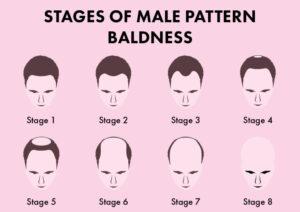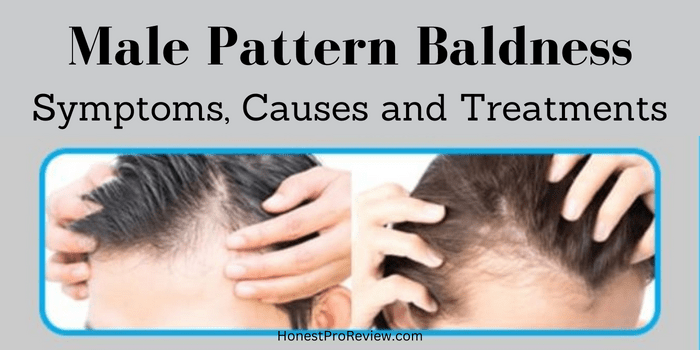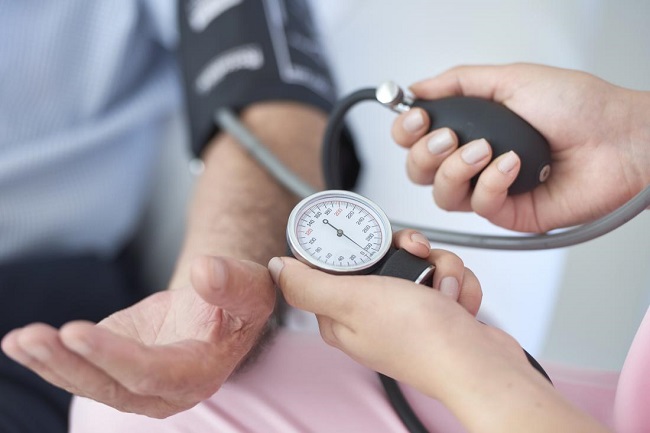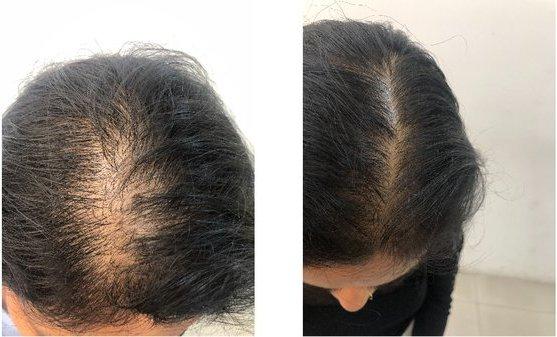Male Pattern Baldness – Symptoms, Causes, and Treatments
Last Updated on – June 26, 2025 by Robert Dowling
All about Male Pattern Baldness: A type of baldness in men brought on by hormonal or genetic factors is known as male pattern baldness. By the time men are in their 50s, more than 50% of them will be affected by it, making it by far the most widespread cause of hair loss in males.
Male pattern baldness can occur at any age, though it is more common in middle and older aged men. In their twenties and thirties many men will notice the first symptoms of this illness, which typically manifest as both a receding hairline and hair thinning.
Male pattern baldness may be to blame if you start to notice your hairline gradually receding or more hair in the sink after taking a shower.
Androgenic alopecia is another name for male pattern baldness. Your genetic and specific androgenic hormones, including testosterone and DHT, are the main contributors to male pattern baldness.
Contrary to popular opinion, factors such as hat use and the use of specific shampoos and other hair products have not been demonstrated to enhance the risk of male pattern baldness.
Naturally, when you begin to realize you’re shedding your hair, it’s all too simple to enter freak-out gear. The excellent update is that you have a lot of solutions at your disposal that can assist you in maintaining your current hair and even start to grow it back.
Male Pattern Baldness Symptoms

Of course, actual hair loss is the key sign of male pattern baldness. However, male pattern baldness-related hair loss can manifest itself in a number of factors, including receding hairline and thinning hair.
Male pattern baldness-related hair loss can sometimes develop quite gradually. For a long time, you might not even examine the telltale hair loss signs, but one day you suddenly find them gazing back to you through the mirror.
Receding Hairline
A receding hairline is typically the first indication of hair loss in men. The common widow’s peak are the corners receding more often than the front part of the hairline, is caused by male pattern baldness.
Naturally, not all hairline thinning follow this precise pattern. Some male pattern baldness sufferers have uniformly receding hairlines. However, the majority of men will experience the widow’s peak trend of hair loss, which is a sign underlying male pattern baldness.
Crown Hair Loss
Men might also experience male pattern baldness in other ways besides hair loss somewhere at hairline. If you have a high risk of developing male pattern baldness and don’t see a thinning hairline, you may be losing hair around your crown towards the back of the head.
The fact that men have a harder time identifying this sort of hair loss throughout the mirror means that it frequently goes undiscovered until it has proceeded to a more severe degree. Using a portable mirror or simply snapping a picture of the rear of your head is the easiest method to see for yourself.
General Thinning of Hair
Diffuse hair loss, also known as diffuse thinning, is indeed a form of baldness that causes an entire thinning of the whole scalp without any obvious problems with your hairline.
Diffuse hair loss usually results from male pattern baldness, even though it happens less often than thinning along the hairline or around the crown. Typically, bright lighting or wet hair are the best conditions to detect this type of hair loss.
Main Features
- More than 50% of all men have the kind of hair loss known as male pattern baldness.
- Even though the majority of men begin losing their hair in their forties and fifties, it can start as early as adolescence.
- Male pattern baldness, also known as androgenic alopecia, is mostly brought on by heredity and the DHT.
Causes of Male Pattern Baldness
DHT, often known as androgen, is a man hormone that the body naturally produces. Since DHT is a residue of testosterone, the body naturally converts some amounts of testosterone into it on a regular basis.
Your ability to develop male characteristics depends on DHT. We’re discussing traits often associated with guys, such as body hair, a higher voice, increasing physical bulk, and sexual development. Sadly, DHT also serves as the main contributor of male pattern baldness.
DHT binds to hair follicles within the scalps of men who are genetically predisposed to hair loss, which results in hair loss. As a result, hair development inevitably slows down, and the hair follicle finally stops being able to produce new hairs.
For some who are fortunate enough, there is no hereditary tendency to DHT, and they suffer little to no loss of hair. However, some men have a sensitivity to DHT and might start losing their hair as early as the early twenties or even as teenagers.
Risk Factors with Male Pattern Baldness
Genetics – You are more likely to develop male pattern baldness for some point if there is an ancestral history of the condition, whether on your mom’s or father’s side. It’s a popular myth that women only inherit the “baldness gene” from their mothers.
Age – The longer your hair is susceptible to DHT, the more likely it is that you may have hair loss. Male pattern baldness more frequently affects men in their forties and older for this main reason.
Treatments and medications – Male pattern baldness can become more severe and occur more frequently when prescription medications and medical procedures used to boost testosterone production are used. Use of testosterone-based medicines for the treatment of andropause or low testosterone may hasten the loss of hair.
Hair Loss Treatment and Prevention
Male pattern baldness still has a number of treatment options available even if there is no known cure for it. The crucial thing to remember is that your probability of slowing and stopping additional hair loss increase the earlier you begin treating the male pattern baldness.
Prescription drugs – At the moment, the FDA has approved the use of two drugs for treating male pattern baldness. Finasteride is a prescribed medication that prevents the body from producing DHT, and minoxidil is a therapeutic solution that aids in promoting hair growth.
Hair Transplantation – Hair transplant surgery involves inserting sections of your scalp from the sides and back of your head that have healthy hair into other parts of the scalp that are balding. Hair transplantation is a painful and pricey operation that is typically not covered by insurance firms.
OTC Hair Loss Products – Popular names like Folexin are among the herbal supplement that have demonstrated promising results in slowing or reversing hair loss. These treatments are less intrusive. These kinds of supplements frequently function by preventing the body from producing DHT, by directly affecting the scalp, and by delivering nutrients to the hair follicles. Men’s hair regeneration utilising some of these treatments has generally shown positive outcomes, with the most
Laser technology – Laser light technology is a promising field in the hair restoration world, and it has produced excellent outcomes for many men. These devices function by boosting blood flow toward the follicle and promoting new growth utilizing laser lights. These gadgets are a non-invasive, safe, and relatively pricey technique to cure hair loss.
All of these treatments, with the exception of transplant surgery, require continued use. It is indeed crucial to keep in mind that these treatments work best when you begin using them as soon as you notice the first symptoms of hair loss.
![]()







